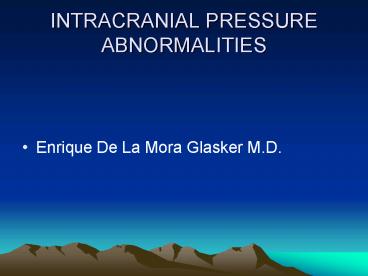INTRACRANIAL PRESSURE ABNORMALITIES - PowerPoint PPT Presentation
1 / 20
Title:
INTRACRANIAL PRESSURE ABNORMALITIES
Description:
Lumbar CSF pressure may not accurately reflect intracranial pressure (ICP) ... space, but CSF cannot drain through arachnoid villi into superior sagital sinus ... – PowerPoint PPT presentation
Number of Views:708
Avg rating:3.0/5.0
Title: INTRACRANIAL PRESSURE ABNORMALITIES
1
INTRACRANIAL PRESSURE ABNORMALITIES
- Enrique De La Mora Glasker M.D.
2
Intracranial hypertension
- Most oftenly associated with
- 1) Rapidly expanding mass lesion
- 2) CSF outflow obstruction
- 3) Cerebral venous congestion
- gt250 mm CSF manifestation of serious neurlogic
disease - Lumbar CSF pressure may not accurately reflect
intracranial pressure (ICP)
3
Signs of increase ICP
- Headache
- Papilledema most reliable sign of ICP
- If ICP approaches the systolic blood pressure,
the cerebral perfusion pressure decreases and
irreversible ischemia may develop
4
Idiopathic intracranial hypertension
- A syndrome of increased ICP accompanied by
- No localizing neurologic signs
- No intracranial mass lesion
- No CSF outflow obstruction
- An alert, otherwise healthy-looking patient
- Almost always obese, oftenly female
- Can be associated with a variety of systemic and
iatrogenic disorders - Unknown cause
5
Pathophysiology of idiopathic intracranial
hypertension
- Etiology is unknown, but is speculated as
- 1) increase in dural sinus venous pressure
- 2) increase in CSF outflow resistance
- 3) increased CSF formation rate
- 4) some combination of the above
- The constancy of obesity has sugested the
possibility of hypothalamic disorder
6
Clinical manifestation of idiopathic intracranial
hypertension
- Headache-most common
- Bilateral papilledema-almost always present
- Nausea/vomiting
- Visual disturbance
- Retro-ocular pain
- Diplopia
- Tinnitus
- vertigo
7
Empty sella syndrome
- In Chronically increased ICP
- 1) radographically globular enlargement of the
sellar turcica - 2) incompetent diaphragma sellae
- 3) Compressed, but functioning pituitary gland
8
Tx of idiopathic intracranial hypertension
- Four (4) general approaches
- 1.-repeated lumbar puncture
- 2.-Pharmacologic treatment
- 3.-Shunting (Ventriculosystemic or
lumbo-peritoneal) - 4.-incision of optic nerve sheath
9
Hydrocephalus
- Net accumulation of CSF within the cerebral
ventricles and their consequent elargement - CSF pressure is frequently normal (or low) in
chronic hydrocephalus
10
Hydrocephalus classification
- 1.-Obstructive
- A.-non- communicating
- Caused by lesions obstructing intracerebral CSF
circulation at or proximal to foramina of Luschka
and Magendie. - B.-Communicating
- Caused by obstruction of basal cisterns or
convexity subarachnoid space with ventricular
system communicating with spinal subarachnoid
space, but CSF cannot drain through arachnoid
villi into superior sagital sinus - 2.-Non-obstructive
11
Hydrocephalusacute vs. chronic
- Complete ventricular outflow obstruction
- Acute hydrocephalus
- Coma
- (death)
- Aqueductal stenosis
- Complications of subarachnoid hemorrhage
- Chronic hydrocephalus
12
Chronic hydrocephalus
- In many instances, the cause of symptomatic
chronic hydrocephalus cannot be determined. - (Normal pressure hydrocephalus)
13
Clinical manifestations of hydrocephalus
- Acute obstructive hydrocephalus
- Severe headache
- Lethargy
- Signs of increased ICP
- Papilledema
- Abducens palsy
- Signs of causative lesion
- Hypereactive reflexes
- Bilateral extensor planter responses
14
Clinical manifestation of hydrocephalus
- Chronic communicating hydrocephalus
- Progressive dementia
- Unsteady gait
- Urinary incotinence
- Bilateral pyramidal and extrapyramidal signs
15
Tx of hydrocephalus
- Acute hydrocephalus
- Ventricular drainage and CSF diversion
16
Intracranial hypotension
- Low or zero lumbar CSF pressure (nl70-200 mm CSF
5-15 mm Hg)
17
Intracranial hypotension
- CSF fìstula
- Post-Lumbar puncture drainage
- Spontaneus-idiopathic, dural nerve sheath tear.
- Sever throbbing fronta and occipital headache
- Within 30 sec. After changing posture to erect
- Subsides completely when lying flat
- (dizzines, nausea, stiff neck, Photophobia)
18
Intracranial hypotension
- Spontaneous intracranial hypotension is rare.
- Unknown etiology
- Spontaneous recovery in days to a few weeks.
19
Tx of intracrania hypotension
- Epidural blood patch
- Injection of 10 ml of patients own blood into
the epidural space
20
(No Transcript)































